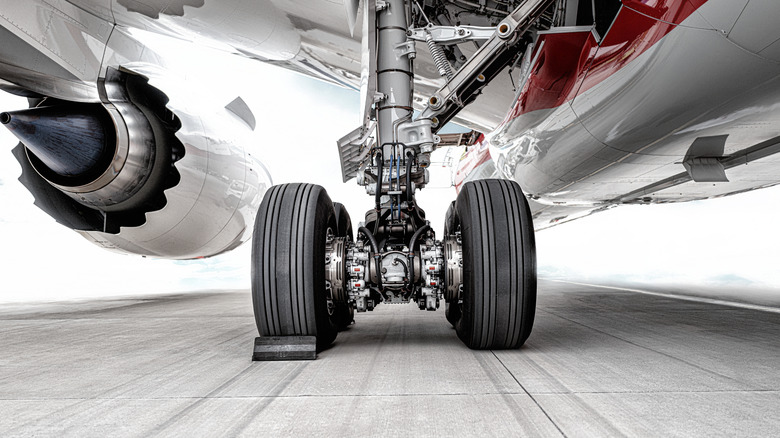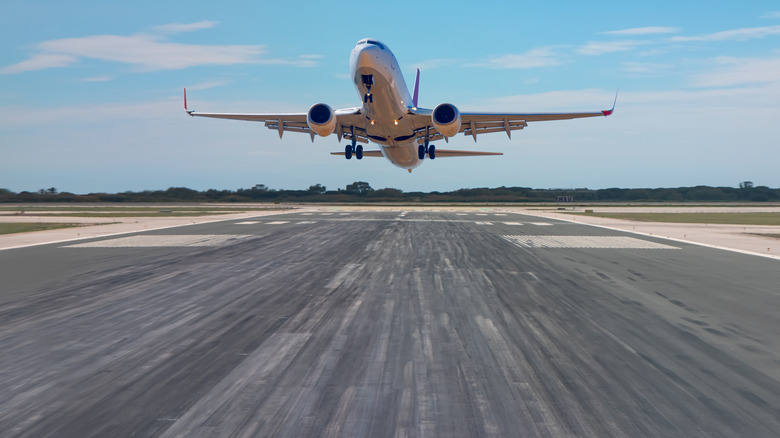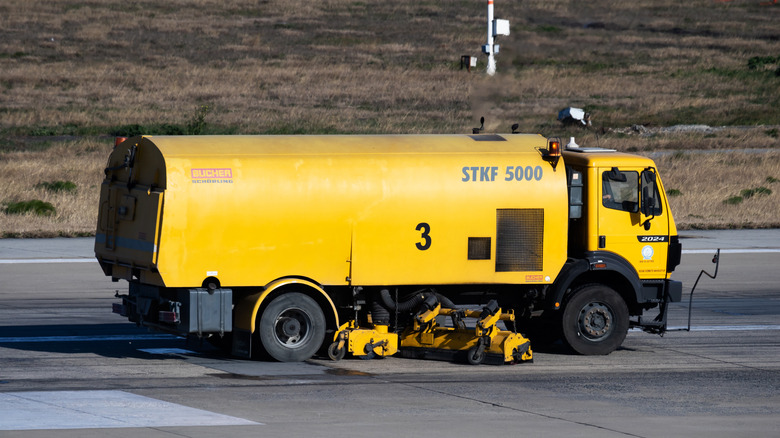How Much Rubber Do Airplane Tires Leave On The Runway? (And How It's Removed)
Tires are one of the most crucial components in any modern commercial aircraft, bearing the responsibility of controlling massive airframes containing potentially hundreds of passengers safely during taxi, takeoff, and landing. Various major companies like Dunlop and Goodyear produce these tires at a cost of several thousand dollars apiece, owing to their overbuilt nature to ensure they always perform as-advertised. Nowhere is this more critical than landing, the most punishing phase of the flight for the tires themselves.
At touchdown, each tire sheds roughly one and a half pounds of rubber on the runway, multiplied by the number of tires on the aircraft. This means that on a typical Airbus A320 with six tires, it sheds about nine pounds of rubber per landing. An A380, with 22 tires, loses some 30-plus pounds of rubber, effectively using a whole truck tire's worth of rubber in one landing.
All of this rubber gets deposited where the planes touch down, building up a layer that needs to be periodically shaved off. In the United States, it's recommended that busy airports with at least 210 daily landings check the amount of rubber deposits at least once a week. Usually, this is done using one or more of several methods: high-pressure water blasting, chemical solvents, superheated pressurized air, and shot blasting. The most common method is water blasting, due to being eco-friendly and not damaging the runway surface. Let's discuss more about each method and why this maintenance is so important.
Why rubber poses a safety hazard on runways
If you look closely at regular pavement, you'll notice that it's not flat, but rather porous. That's by design; if a road were perfectly polished smooth, water wouldn't have anywhere to go, instead pooling on the surface. This phenomenon creates a frictionless barrier between the tire's rubber and the road surface, called hydroplaning. A road's imperfections, coupled with a tire's tread pattern, provides water with places to go, allowing the tires to grip the exposed road surface.
The dangers posed by hydroplaning are the main reason why many runways feature deep grooves cut in them, acting like channels during rainfall. In addition, because these grooves run across the runway rather than lengthwise, they will interlock with the tire tread and shorten stopping distances. The issue, however, is that when a plane lands, the tire isn't spinning and skids as soon as it touches down. This melted rubber will then sink down into those grooves, smoothing them over time and diminishing their effects. This may ultimately result in water pooling on the smooth surface, causing the aircraft to hydroplane in the touchdown zone.
Every major airport utilizes systems to assess runway grip conditions based on numerous factors, such as precipitation, contaminants, and cracks. According to the TALPA runway condition guidelines, rubber in the landing zone indicates a "slippery when wet" condition for the runway, and is potentially hazardous in damp weather. Furthermore, rubber buildup also has secondary effects, like dimming runway lights if they're impacted by burnt rubber particles that melt onto the light housing.
How to safely remove rubber contamination from runways
John F. Kennedy Airport, serving New York City, sees enough aircraft per day to deposit approximately 13,200 pounds of rubber on its runways. The first task in cleaning all of this rubber is detection; airports use various specialized equipment, such as a car fitted with a device that measures the runway's physical properties.
After it's been determined that a runway requires cleaning, airports use several methods depending on various factors, such as the contamination severity, runway material, and the tools available. A common method is water blasting, ranging from handheld pressure-washers not unlike pressure washers you use to detail your car, to semi-trucks fitted with ultra-high pressure bars designed to clean wider areas. However, its effectiveness decreases with severity and depth. For more extreme cases, airports use chemical solvents to break up rubber before sweeping them away, sometimes used in conjunction with pressure-washing. And lastly, one method involves melting the rubber with hot compressed air, fed out of a nozzle that blasts superheated air onto the runway surface to instantly melt and blow away the rubber.
Some methods are particularly effective but may damage the runway surface, and so are seldom-used. For instance, leaving the chemical solvents on for too long can strip paint and even layers of pavement from the runway. Shot blasting, which peppers the surface with steel balls (like a continuously firing shotgun) acts like a rigorous sand-blaster, stripping the rubber and occasionally the top surface of the runway in the process. As such, you'll most often find busy airports utilizing a mixture of chemical solvents and pressure-washing to maintain peak runway conditions.


